During the 14 years which comprise the Weimar period, the German film industry enjoyed an unprecedented development. Each year, an average of 250 films were produced and about 230 film companies were active in Berlin alone. This month we will focus on the men and women who directed these films. The most famous directors in this industry were Fritz Lang, Friedrich Wilhelm Murnau and Ernst Lubitsch who all later had success in Hollywood and about whom we posted before. In this post, EFSP presents 11 directors who were less famous but who all made several interesting silent films during the 1910s and 1920s.
Fern Andra

German postcard by Ross Verlag, Berlin, no. 288/2, 1919-1924. Photo: Fern Andra Atelier. Caption: Fern Andra in ihrem Heim (Fern Andra at her home).
American actress and director Fern Andra (1893-1974) became one of the most popular film stars of German cinema in the 1910s and early 1920s. In 1913, aged 19, she appeared in her first German film, Das Ave Maria/The Ave Maria (Charles Decroix, 1913). Soon she started her own company, even directing her own films. Georg Glen was the manager of her studio, Fern Andra Atelier. The company produced more than 80 films during World War I.
Fern Andra appeared mainly in sentimental dramas but also impressed critics with artistic performances in circus films. The new star created a sensation by mastering tight roping, riding horses without a saddle, driving cars and motorcycles, bobsleighing, and even boxing. Her films included Eine Motte floh zum Licht/A Moth Flew To The Light (Fern Andra, 1915), Frühlingsstürme im Herbste des Lebens/Spring Storms (Fern Andra, 1918) and Drohende Wolken am Firmament/Threatening Clouds in the Sky (Fern Andra, 1918). Unfortunately, most of these films are lost now. In the early 1920s, Andra's films became more sophisticated. She then left direction to directors such as Robert Wiene.

German postcard in the Film Sterne Series by Rotophot, no. 523/8. Photo: Fern Andra Atelier. Fern Andra in Es fiel ein Reif in der Frühlingsnacht/There was frost in the spring night (Fern Andra/ Kurt Matull, 1915). Collection: Didier Hanson.

German postcard in the Film Sterne series by Rotophot, no. 557/4. Photo: Fern Andra Atelier. Fern Andra in Drohende Wolken am Firmament/Threatening clouds in the sky (Fern Andra, 1918), scripted by Fern Andra.

German postcard by Ross Verlag, no. 580. Photo: Fern-Andra-Atelier. Fern Andra in Der Todessprung/Um Krone und Peitsche/Crown and Whip (Georg Bluen, Fern Andra, 1919).
Harry Piel

German postcard by Photochemie, Berlin, K 1481. Photo: Willinger, Berlin.
German ‘dynamite’ director, actor, producer and screenwriter Harry Piel (1892-1963) made over 150 sensational films full of explosions and stunts. In 1912 he moved to Berlin where he founded his first film company, the Kunst-Film-Verlags-GmbH. His debut as a director-writer-producer was the adventure film Schwarzes Blut/Black Blood (Harry Piel, 1912) starring Curt Goetz. Even though his company went bankrupt, Piel had become established.
In the following years, he shot dozens of short films full of action and adventure such as Der Triumph des Todes/The Triumph of the Death (Harry Piel, 1912), Ein Millionenraub/A million Robbery (Harry Piel, 1914), and Die grosse Wette/The Large Bet (Harry Piel, 1916), all starring Ludwig Trautmann. As a director, he had the nickname ‘the dynamite director’ because of all the exploding bridges and houses in his films. These explosions were often authentic. A demolition engineer notified him about forthcoming blow-ups. He filmed the explosions and inserted the footage into his films.
In 1915, Harry Piel became too bored with just standing behind the lens and started acting before the camera. His first film as a leading actor, Die große Wette/The Large Bet (Harry Piel, 1916), was a Science Fiction film on the subject of man-machines. In Unter heißer Zone/Under the Hot Sun (Harry Piel, 1916) he used scenes with wild animals for the first time. During 1918 and 1919, Piel directed and starred in eight films of the Joe Deebs, private investigator series. Sadly not many of the films of his best period - the 1920s - have survived: 72 negatives of his films, including nearly all his silent pictures, perished in a WWII air raid.

German postcard by Ross Verlag, no. 1172/2. Harry Piel in the period piece Zigano, der Brigant von Monte Diavolo (Harry Piel, Gerard Bourgeois, 1925) for which the exteriors were shot in Rome.

German postcard by Ross Verlag, Berlin, no. 1629/1, 1927-1928. Photo: Nero-Film, Berlin. Harry Piel in Was ist los im Zirkus Beely?/The Phantom of the Circus (Harry Piel, 1927).

German postcard by Ross Verlag, Berlin, no. 3343/2, 1928-1929. Photo: Ufa. Harry Piel in Panik/Panic (Harry Piel, 1928).
Friedrich Zelnik

German postcard in the Film Sterne series by Rotophot, no. 82/1. Photo: Karl Schenker, Berlin.
Austrian actor Friedrich Zelnik or Frederic Zelnik (1885-1950) was one of the most important producers-directors of the German silent cinema. Already in the early 1910s, he became a film star in Germany. In 1915, he started producing and directing films such as the Charles Dickens adaptation Klein Doortje/Little Dorrit (Friedrich Zelnik, 1917) while playing parts in other directors’ films too.
In 1918, Friedrich Zelnik met a young Polish ballet dancer turned film actress named Lya Mara in Warsaw. They married and he started to produce and direct films for her. He made Mara a huge star of the German cinema. Between 1917 and 1922, the Berliner Film-Manukfaktur produced more than 120 films. From 1920, Zelnik's companies ran under several names: Zelnik-Mara-Film GmbH, Friedrich Zelnik-film GmbH, and Efzet-Film GmbH. Zelnik-Mara-Film GmbH produced silent entertainment films in which Lya Mara was the female star.
Together they made very popular, operetta style costume films like An der schönen blauen Donau/The Beautiful Blue Danube (Friedrich Zelnik, 1926), Die Försterchristl/The Bohemian Dancer (Friedrich Zelnik, 1926), Das Tanzende Wien/Dancing Vienna (Friedrich Zelnik, 1927), and Heut' tanzt Mariett/Marietta (Friedrich Zelnik, 1928). A critical success was his drama Die Weber/The Weaver (1927).
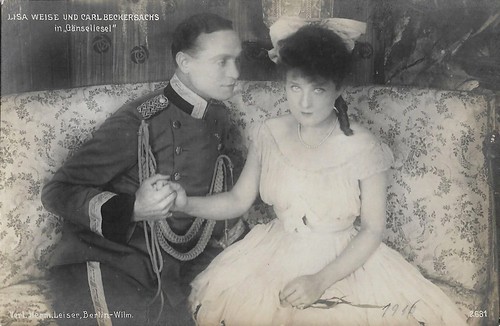
German postcard by Verlag Hermann Leiser, no 2681. Photo: Berliner Film-Manufaktur. Lisa Weise and Karl Beckersachs in Gänseliesel (Friedrich Zelnik, 1918).

German postcard by Ross Verlag, Berlin, no. 77/3. Photo: Zelnik-Film. Hertha von Walther, Wilhelm Dieterle and Hermann Picha in Die Weber (Friedrich Zelnik, 1927).

German postcard by Ross Verlag, no. 3413/1. Photo: Defina / Defu. Lya Mara in Heut tanzt Mariett (Friedrich Zelnik, 1928).
Lupu Pick

German postcard by Ross Verlag, no. 23/1, 1925-1935. Photo: Atelier Bieber, Berlin.
Romanian-born actor and director Lupu Pick (1886-1931) started as a silent film actor in German film in 1910. In 1917 he founded the film company Rex-Film AG. From 1918 he would also become a prolific film director, known for e.g. his Kammerspielfilms Scherben (Lupu Pick, 1921) and Sylvester (Lupu Pick, 1924).
Lupu Pick served on the board of the Film Association of Industrialists (Vorstand des Verbandes der Filmindustriellen), SPIO and the Film Directors Association of Germany (Verbandes der Filmregisseure Deutschlands) and worked intensively to establish the union-based umbrella organisation of Filmmakers in Germany (Filmschaffenden Deutschlands) (Dacho). He was the organization's first chairman. Pick was married to actress Edith Posca.

German postcard by Photochemie, Berlin, no. K. 2276. Photo: Berliner Film-Manufaktur. Friedrich Zelnik and Lupu Pick in Die Rothenburger/The Rothenburgers (Lupu Pick, 1918).
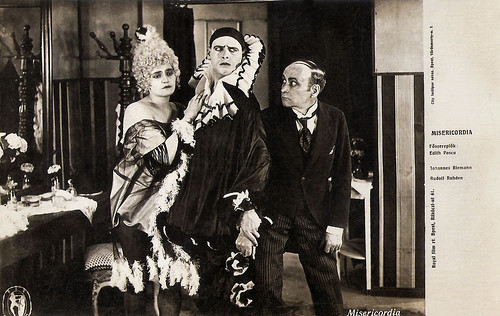
Hungarian postcard by City fotóipar soksz, Budapest. Photo: Rex Film / Royal Film, Budapest. Johannes Riemann, Edith Posca and Rudolph Klein-Rohden in Tötet nicht mehr/Don't kill any more (Lupu Pick, 1920).

German postcard by Ross Verlag, no. 115/1. Photo: D.L.S. (Deutsche Licht-Spiele). Werner Krauss in Napoleon auf St. Helena/Napoleon at St. Helena (Lupu Pick, 1929).
Richard Eichberg
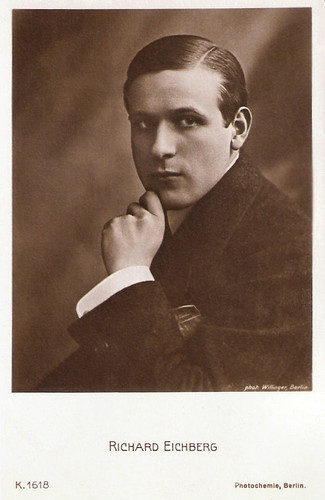
German postcard by Photochemie, Berlin, no. K.1618. Photo: Willinger, Berlin.
Richard Eichberg (1888-1953) was a German film director, actor and producer, who directed almost 90 films. In 1915 he switched from film acting to film direction and production, which success led to founding his own company, Richard Eichberg-Film. Eichberg mostly made criminal melodramas which were action-driven and full of exoticism and sensation. His team was the thriving force in the late 1910s of films starring Ellen Richter (such as Bacchanal des Todes, 1917), Leontine Kühnberg, and from 1919, Eichberg’s wife Lee Parry (e.g. Die Motorbraut, 1924).
After he divorced Parry, he launched Lilian Harvey in his 1925 film Leidenschaft, and first united her with Willy Fritsch in 1926 in Die keusche Susanna. He soon lost them to the big Ufa company, where they would become a beloved couple of late silent and early sound cinema in Germany. Afterwards, Eichberg discovered Anna May Wong, Marta Eggerth and Kitty Jantzen (his second wife) but couldn’t keep them either. From the early 1920s, Eichberg focused on frivolous and light film comedy, which highly pleased audiences but not the critics. Examples are Durchlaucht Radieschen (1927) with Xenia Desni and Der Fürst von Pappenheim (1927) with Curt Bois.
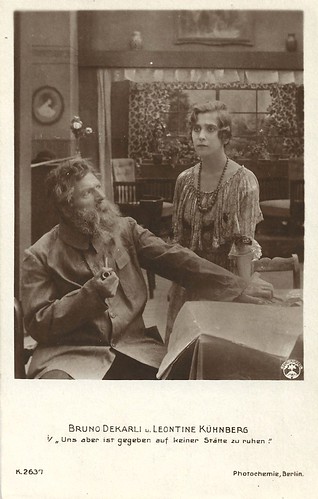
German postcard by Photochemie, Berlin, no. K.2637. Photo: Eichberg-Film. Bruno Decarli and Leontine Kühnberg in Uns aber ist gegeben auf keiner Stätte zu ruhen (Richard Eichberg, 1918). The film title Uns aber ist gegeben auf keiner Stätte zu ruhen [But to us, it is given to rest on no place] is absent on IMDb and Filmportal.de. From the six films that Richard Eichberg directed with Leontine Kühnberg in 1918, all for his own company Eichberg-Film, a probable option is Im Zeichen der Schuld (Eichberg, 1918), aka Aus dem Leben eines Vorbestraften [From the life of a convicted man]. Filmportal.de lists this as the only film in which Decarli and Kühnberg played together in an Eichberg-Film production. However, the Early German Film Database does list the film Uns aber ist gegeben, auf keiner Stätte zu ruhen (1918) as a separate film directed by Eichberg and starring Decarli and Kühnberg.

German postcard by Ross Verlag, Berlin, no. 877/2, 1925-1926. Photo: Heinrich Gärtner, Berlin / Richard Eichberg-Film, Berlin. In 1925, Lee Parry starred in four films, produced by Richard Eichberg-Film with cinematography by Heinrich Gärtner: Die Motorbraut/The Motor Bride (Richard Eichberg, 1925), Luxusweibchen/Luxury Wife (Erich Schönfelder, 1925), Die Frau mit dem Etwas/The woman with something (Erich Schönfelder, 1925), and Der Liebeskäfig/The Love Cage (Richard Eichberg, Erich Schönfelder, 1925).

German postcard by Ross Verlag, no. 1394/1, 1927-1928. Photo: Hameister / Eichberg Film G.m.b.H. Lilian Harvey and Harry Liedtke in Liebe und Trompetenblasen/Love and Trumpet Playing (Richard Eichberg, 1925). Collection: Didier Hanson.
Max Mack

German postcard by Photochemie, no. K.2134. Photo: Mac Walten.
Max Mack (1884-1973) is known as one of the pioneers of German silent cinema. He had his directorial debut with Ein seltener Fall (1911) for Deutsche Mutoskop und Biograph. He also worked at Vitascope as director, first on Gehirnreflexe (1911). From 1912 until the end of the First World War, Mack was one of the most productive filmmakers, working for Deutsche Mutoskop und Biograph, Vitascope, Continental-Kunstfilm, e.g. Zweimal gelebt (1912) and Eiko-Film, e.g. Der stellungslose Photograph (1912) with Hanni Weisse.
Mack paid much attention to modernity. His frontal, symmetric compositions betray his background in theatre. Mack's film Der Andere/The Other (1913) with Albert Bassermann in the double lead role deals with schizophrenia. It is considered the first German Autorenfilm. A public success was the crime comedy Wo ist Coletti?/Where is Coletti? (1913), starring Hans Junkermann. It was one of the first fiction films to explicitly exploit the urban landscape of Berlin. In Die Blaue Maus (1913), starring Madge Lessing, he showed his predilection for urban nightlife. Mack's modernity was also expressed in his emancipatory themes, crossdressing and masquerades such as in Die Welt ohne Männer (1914) with Madge Lessing.
In 1916, with Ewald André Dupont, Max Mack published one of the first books on film theory, 'Die zappelnde Leinwand' (The Fidgeting Canvas). In 1917 he founded his own production company, Max Mack-Film GmbH, which merged in 1919 with Solaris Film. Mack took part in the late 1910s popular genre of the Aufklärungsfilm with Der Sohn der Magd. In 1920 he quit the company and hence worked for a wide range of firms, including Terra-Film, e.g. Figaros Hochzeit (1920), Esha-Film, International-Film AG, Ufa and Sokal-Film. In the 1920s Mack worked in a wide range of genres: moral dramas, literary adaptations, realist melodramas, comedies, and even tourist films.
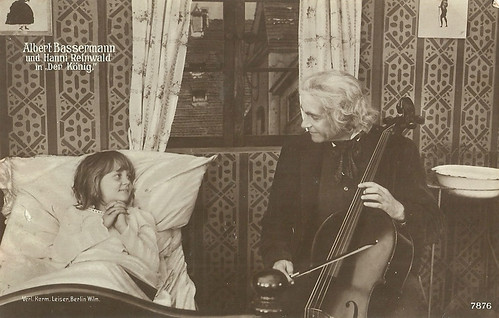
German postcard by Verlag Hermann Leiser, Berlin, no. 7876. Photo: Vitascope. Albert Bassermann and Hanni Reinwald in the film Der König (Max Mack, 1913), based on the novel by Richard Fischer.
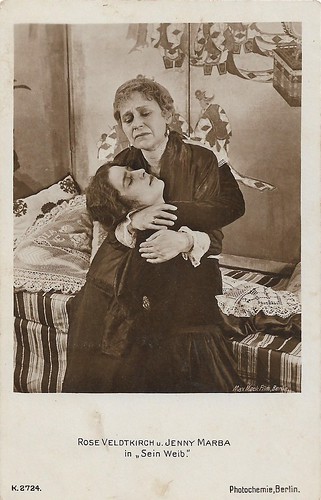
German postcard by Photochemie, no. K.2724. Photo: Max Mack-Film. Rose Veldtkirch and Jenny Marba in Sein Weib (1918). The film is considered to be lost.
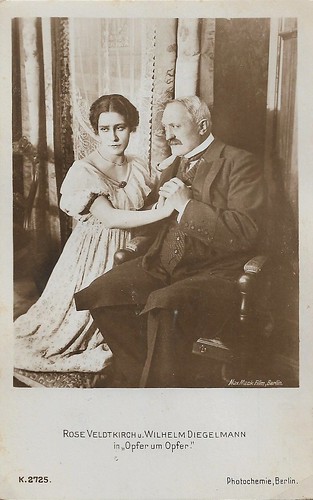
German postcard by Photochemie, no. K.2725. Photo: Max Mack-Film. Rosa Veldtkirch and Wilhelm Diegelmann in Opfer um Opfer (Max Mack, 1918). The film is considered to be lost.
Joe May

German postcard by Ross Verlag, no. 972/1, 1925-1926. Photo: May-Film.
Joe May (1880-1954) was an Austrian film director and producer, considered one of the pioneers of German cinema. In 1914 he founded his own production company, May-Film, and started to produce a series of crime films with the detectives Joe Deebs and Stuart Webbs. In 1917 he offered Fritz Lang one of his first jobs in the film world as the screenwriter of Die Hochzeit im Excentricclub.
At the end of the First World War, Joe May founded a studio complex at the Weissensee outside of Berlin. There he continued to produce and direct a series of popular and exotic adventures, e.g. Veritas vincit (1919), Die Herrin der Welt (1919-20) starring his wife Mia May, as well as the two-part film Das indische Grabmal/Der Tiger von Eschnapur (1921) starring Conrad Veidt and scripted by Fritz Lang and Thea von Harbou.
Mia May worked under her husband's direction in several melodramas such as Hilde Warren und der Tod (1917) and Tragödie der Liebe (1922-1923). Towards the end of the 1920s May left the adventure genre and focused on realist films, such as Heimkehr ((1928), with Dita Parlo, and the contemporary comical thriller Asphalt (1929), starring Gustav Fröhlich and Betty Amann.

German postcard by Ross Verlag, no. 634/6. Photo: May Film. Mia May in Die Herrin der Welt/Mistress of the World (Joe May and others, 1919). Mia May as Maud Gregaard, who at one point is considered the reincarnation of the goddess Astarte.

German postcard by Rotophot in the Film Sterne series, no. 566/3. Photo: May Film. Mia May and Magnus Stifter in Veritas vincit. Der grosse Prunkfilm (Joe May, 1919). Caption: Die Brautnacht des Decius (Decius' Wedding Night).

German postcard by Rotophot in the Film Sterne series, no. 516/3, 1919-1924. Photo: May-Film. Mia May and Bruno Kastner in Hilde Warren und der Tod/Hilde Warren and Death (Joe May, 1917).
Rosa Porten
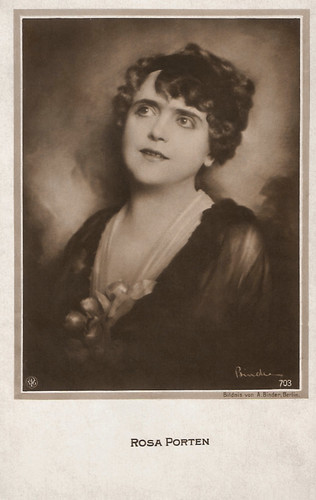
German postcard by NPG, no. 703. Photo: Alex Binder, Berlin.
Rosa Porten (1884-1972) was the elder and lesser-known sister of German silent film star Henny Porten. Both sisters started in 1906 as an actress for the pioneering Messter company and Rosa became one of the first women in Germany to write and direct films. In the 1910s Porten was extremely active as a screenwriter for Messter and wrote such 20-minute films as Das große Schweigen/The Great Silence (Rudolf Biebrach, 1915) starring her sister Henny.
For the Treumann-Larsen company, she and her husband Franz Eckstein wrote many scripts under the pseudonym of Dr. R. Portegg and they also directed these films. In some of these films, she even played the female lead too, such as in Die Wäscher-Resl (1916), the comedy Die Erzkokette (1917) with Reinhold Schünzel, the fast-paced comedy Die Landpommeranze/The Unwieldy Country Woman (1917), Die Augen der Schwester/The Eyes of the Sister (1918), and Themis (1918).
In other examples of Treumann-Larsen productions like Das Opfer der Yella Rogesius/The Sacrifice of Yella Rogesius (1917) and Wanda's Trick (1918), Wanda Treumann played the lead. Probably the last film, which the couple Eckstein-Porten directed together, was Der nicht vom Weibe geborene (Franz Eckstein, Rosa Porten, 1918), starring Conrad Veidt as Satan. In the 1920s, Rosa Porten and Franz Eckstein went to work for the National-Film AG in Berlin, but with Porten only as a screenwriter and Eckstein as director.

German postcard by Verlag Hermann Leiser, Berlin, no. 3240. Photo: Treumann-Larsen-Film. Rosa Porten in Gräfin Maruschka (Franz Eckstein, Rosa Porten, 1917).

German postcard by Verlag Herm. Leiser, Berlin-Wilm., no. 3237. Wanda Treumann in Das Teufelchen/The little devil (Rosa Porten, 1917).

German collectors card by Ross Verlag for the album Vom Werden deutscher Filmkunst. Teil I. Der stumme Film (Cigaretten-Bilderdienst Altona-Bahrenfeld 1935), Bild no. 43, Gruppe 41. Photo: Treumann-Larsen-Film. Eduard von Winterstein, Rosa Porten and Reinhold Schünzel in Die Erzkokette/The Superflirt (Franz Eckstein, Rosa Porten, 1917).
Ernst Reicher

German postcard by Photochemie, Berlin, no. K.1325.
Ernst Reicher (1885-1936) was a German stage and screen actor, director, screenwriter and producer, famous for his Stuart Webbs detective films. Reicher's directorial debut was in the 1913 film Das Werk. At the end of 1913, Reicher invented the character of the detective Stuart Webbs. In this role, he stood before the camera for twelve years and established the detective genre in German cinema. He introduced Webbs in Der geheimnisvolle Villa (Joe May, 1914), for the Continental Art Film GmbH. The most popular of the Stuart Webbs films at Continental was Das Panzergewölbe (Joe May, 1914).
After arguing with Continental, Reicher and Joe May formed their own production company in 1914 called "Stuart Webbs Film Company" and opened a studio at Berlin Weissensee. Already in 1915 May withdrew and launched his own Joe Deebs detective series. Throughout the First World War, Stuart Webbs, a gentleman detective based on the model of Sherlock Holmes, was popular with German audiences. Only in 1918, Reicher turned to other topics
His most elaborate production was the epic film Das Buch Esther (Uwe Jenns Kraft, Ernst Reicher) 1919), with Stella Harf in the title role and himself as King Ahasverus. Harf had the female lead in several of Reicher’s late 1910s films. In 1919, Ernst Reicher moved the seat of his film company to Munich. In 1921 he suffered a serious car accident in which he had a skull fracture and a spinal fracture, causing a gap in his career between 1921 and 1923. Reicher continued to produce films with his own company till 1923 and occasionally afterwards.

German postcard by Photochemie, Berlin, no. K.1822. Photo: A. Binder, Berlin. Ernst Reicher as Stuart Webbs.

German postcard by Photochemie, Berlin, no. K. 2334. Photo: Alba-Film, Berlin. Stella Harf and Bruno Kastner in Die Fürstin von Beranien (Ernst Reicher, 1918).

German postcard in the Film-Sterne series by Rotophot, no. 62/2. Photo: Karl Schenker, Berlin / Webbs Film. Detective Stuart Webbs (Ernst Reicher) disguised as an old bearded man.
Victor Janson

German postcard by Photochemie, no. K.172. Photo: Alex Binder, Berlin.
Victor Janson a.k.a. Viktor Janson (1884-1960) was a German actor and director. He played under the direction of Ernst Lubitsch in a large string of films, often with Ossi Oswalda or Pola Negri, including Die Austernprinzessin/The Oyster Princess (1919) and Die Bergkatze/The Mountain Cat (1921). Janson also acted in films by many other German directors.
In 1918 Victor Janson began to work as a director, but he also remained an actor. He debuted with Der gelbe Schein (1918, codirected with Eugen Illés), starring Pola Negri, and with Janson in a supporting part. It is a remarkable philosemitic German drama, partly shot at the Jewish quarter in Warsaw, and initially intended as anti-Russian propaganda. In the early 1920s, Janson directed a series of comedies with Ossi Oswalda, produced by her own film company, such as Amor am Steuer (1921), Colibri (1924), and Niniche (1925).
Janson also directed dramatic films such as Der Trödler von Amsterdam/The Dealer from Amsterdam (1925) starring Werner Krauss, while he continued with romantic comedies such as the period piece Zopf und Schwert – Eine tolle Prinzessin/ Braid and Sword - A Great Princess (1926) with Mady Christians, Wien, du Stadt meiner Träume/Die Königin seines Herzens/Vienna, You City of My Dreams (1927) with Liane Haid, and Es flüstert die Nacht/It Whispers the Night (1929) with Lil Dagover.

German postcard by Ross Verlag, Berlin, no. 685/4, 1919-1924. Photo: Westi-Film. Ossi Oswalda and Victor Janson in Niniche (Victor Janson, 1925).

German postcard by Ross Verlag, no. 65/3. Photo: Aafa-Film. Mady Christians and Victor Janson in Die geschiedene Frau/The Divorcée (Viktor Janson, 1926).

German postcard by Ross Verlag, no. 1467/2. Photo: Aafa Film. Mady Christians in Zopf und Schwert – Eine tolle Prinzessin/Braid and Sword - A Great Princess (Victor Janson, 1926).
Rudolf Meinert
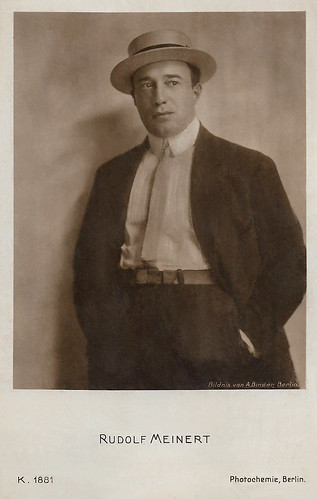
German postcard by Photochemie, Berlin, no. K. 1881. Photo: A. [Alex] Binder, Berlin.
Austrian actor, director and producer Rudolf Meinert (1882-1943) worked from 1913 as a film director in Berlin and usually took over production with his company Prometheus-Film at the same time. Also in 1913, he married the screenwriter Erna Thurk. He had considerable success with his sensational detective films until he was drafted into the war in 1914. As a sergeant, he was seriously wounded and dismissed as a war disabled in 1915. He then founded the Meinert-Film Gesellschaft. From 1916 to 1919 he directed and produced 19 films about the master detective Harry Higgs, starring Hans Mierendorff.
From 1916 to 1920 he was a board member of the Berliner Film Club. In May 1919 he was a co-founder of the first board of directors of the German Film Industry Employers' Association. In November 1919 Meinert-Film merged with Erich Pommer's Decla-Film-Gesellschaft Holz & Co. Meinert became production manager and in this function played a major role in the creation of the silent classic Das Cabinet des Dr. Caligari (Robert Wiene, 1919).
After the merger of Decla with Bioscop AG in 1920, he took over a seat on the supervisory board of the new Uco-Film-Gesellschaft but left the group in 1921. In 1922, he founded a new Meinert Film Society and started to direct a biography of Queen Marie Antoinette. He staged ambitious melodramas and dramas and shot Die Vorbestraften, a socially committed film supported by the Berlin penal authorities. In 1927 he founded the German-Russian Film Alliance (Derussa), for which he made films with an international cast.

German postcard by Photochemie, no. K.2604. Photo: Meinert Film. Ellen Richter in Die schöne Jolan (Rudolf Meinert, 1918), scripted by Willi Wolff. The man on her right is Hugo Flink, Richter's co-actor in this film.
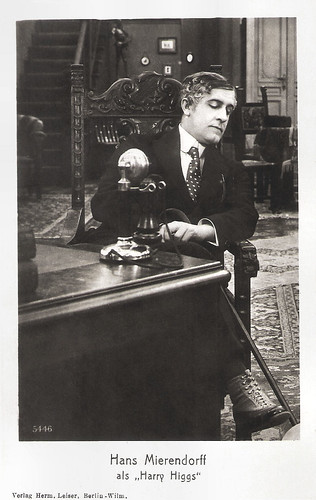
German postcard by Verlag Hermann Leiser, Berlin-Wilm., no. 5446. Hans Mierendorff as Harry Higgs. In 1916-1920, Mierendorff incorporated the detective Harry Higgs in many films, produced and directed by Rudolf Meinert. The first was probably John Rool (1916), and the last was Halloh! Hier Harry Higgs, wer dort? (1919). After that, Mierendorff did one last Harry Higgs film, Der Mann im Nebel (1919-1920), directed by Mutz Greenbaum and produced by the Greenbaum company.

German postcard. Photo: Ifa-Film. Ernst Rückert as Fritz von Wedel in the German silent film Die elf Schill'schen Offiziere (Rudolf Meinert, 1926), a period piece dealing with the failed uprising of Prussian officers against Napoleon in 1809.
Source: Wikipedia. With thanks to Ivo Blom.
No comments:
Post a Comment